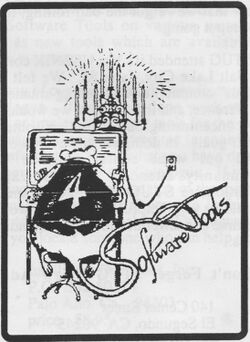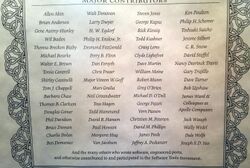Software tools users group
Topic: Organization
 From HandWiki - Reading time: 4 min
From HandWiki - Reading time: 4 min
 The Software Tools Users Group | |
| Formation | 1976 |
|---|---|
| Headquarters | Lawrence Berkeley National Laboratory, Berkeley, California, United States |
Membership | Over 2000 at its peak |
Coordinator | Deborah K. Scherrer |
Key people | Dennis E. Hall, Joseph S. Sventek |
The Software Tools Users Group (STUG) was a technical organization started in 1976, in parallel with Usenix. The STUG goal was to develop a powerful and portable Unix-like system that could be implemented on top of virtually any operating system, providing the capabilities and features of Unix in a non-proprietary system. With its focus on building clean, portable, reusable code shared amongst multiple applications and runnable on any operating system, the Software Tools movement reestablished the tradition of open source and the concepts of empowering users to define, develop, control, and freely distribute their computing environment. [1]
History
In 1976, Brian Kernighan (then of Bell Labs) and P. J. Plauger published Software Tools[2], the first of their books on programming inspired by the recent creation of the Unix operating system by Kernighan’s colleagues at Bell Labs. The "Software Tools" series spread the essence of "C/Unix thinking" with makeovers for Fortran and Pascal [3]. Kernighan’s Ratfor[4] (rational FORTRAN preprocessor) was eventually put in the public domain.
Deborah K. Scherrer, Dennis E. Hall, and Joseph S. Sventek, then researchers at the Lawrence Berkeley National Laboratory quickly picked up the Software Tools book and philosophy. They expanded the initial set of a few dozen tools from the book into an entire Virtual Operating System (VOS), providing an almost complete set of the Unix tools, a Unix-like programming library, and an operating system interface that could be implemented on top of virtually any system. They freely distributed their VOS collection world-wide. Their work generated ports of the software to over 50 operating systems [5] and a users group of more than 2000 [6].
An LBNL research report appeared in Communications of the ACM in September 1980. [7]
Scherrer, also on the Usenix Board at the Time, established and coordinated the Software Tools Users Group, aligning itself with Usenix Starting in 1979, STUG and Usenix held parallel conferences. STUG also produced a series of newsletters [8]. STUG also coordinated with the European Unix Users Group and spawned similar groups in other parts of the world[9].
The Software Tools movement eventually triggered several commercial companies to port and distribute the Software Tools to microcomputer systems such as CP/M and MS-DOS [10]. [11].
Awards
On January 24, 1996, Scherrer’s, Hall’s, and Sventek’s work was recognized with a USENIX Lifetime Achievement Award (“The Flame”). [12] [13] [14] [15] [16]
In 1993 Scherrer had previously been honored with a “UNIX Academic Driver” award presented by Bell Labs, for “Outstanding Contributions to the UNIX community”. Her work included the Software Tools movement as well as contributions to USENIX[17][18].
Other Major Contributors
The Software Tools project was the result of efforts from hundreds of people at many, many sites. The USENIX STUG Lifetime Achievement Award includes the names of many, but certainly not all, major contributors to the Software Tools project.
Legacy
By the late-1980s, Unix was becoming more available, Microsoft had taken over the PC market, and the need for the VOS environment started to subside. The STUG group decided to discontinue, choosing to donate the group’s financial legacy to endow a yearly USENIX “STUG Award”. This award “recognizes significant contributions to the community that reflect the spirit and character demonstrated by those who came together in the Software Tools Users Group. Recipients of the annual STUG Award conspicuously exhibit a contribution to the reusable code base to all and/or the provision of a significant enabling technology to users in a widely available form.” [19] [20] [21].
See also
- USENIX
- Unix
- Open-source model
- Brian Kernighan “The Unix Programming Environment”. Software Practice and Experience, Vol 9, 1979.
- Peter H. Salus A Quarter Century of UNIX. Addison-Wesley: 1994.
- A complete copy of the Software Tools distributions from LBNL, the ports for Unix, CP/M, and MS-DOS, Pascal, and the original set from Addison-Wesley are available in the Computer History Museum and The Unix Heritage Society https://web.archive.org/web/20050831153956/http://www.tuhs.org/. These archives also contain most of the STUG newsletters and related articles.
References
- ↑ Peter H. Salus, A Quarter Century of UNIX, 1994
- ↑ Brian Kernighan, P. J. Plauger, Software Tools. Addison-Wesley: 1976.
- ↑ Brian Kernighan, P. J. Plauger, Software Tools in Pascal. Addison-Wesley: 1981.
- ↑ Brian Kernighan, “A Preprocessor for a Rational Fortran”. Software Practice and Experience, Vol 5, 1975
- ↑ Deborah Scherrer “Not Just a Poor Man’s Unix”. UNIX Review Vol 6 #1: Jan 1988: 56-57
- ↑ Deborah Scherrer “User Spotlight: Software Tools Users Group”. Unix/world Vol. 1, Dec 1984
- ↑ Dennis E. Hall, Deborah K. Scherrer, and Joseph S. Sventek, LBNL, “A Virtual Operating System”, Communications of the ACM, September 1980, Volume 23 #9, 495-502
- ↑ Software Tools Communications. Official newsletter of the Software Tools Users Group. Issues began in 1979 and continued through January 1986. Copies are available at the Computer History Museum and through The Unix Heritage Society http://www.tuhs.org
- ↑ Desmond FitzGerald and Paul Howson, ed. Software Tools Notes: The Australian Journal of Programming Methods for Technical Software. First issue January 1983
- ↑ Deborah Scherrer, Philip H. Scherrer, Thomas H. Strong, Samuel J. Penny. “The Software Tools: Unix Capabilities on Non-Unix Systems”. Byte vol 8 #11, Nov 1983: 430-446
- ↑ Jerry Pournelle “The West Coast Computer Faire”. Byte vol 10 #8, Aug 1985: 308-310
- ↑ “Winners of the USENIX Lifetime Achievement Award (The Flame) – 1996: The Software Tools Project”. https://www.usenix.org/about/awards/flame
- ↑ The USENIX Lifetime Achievement Award (“The Flame”) http://www.usenix.org/about/flame
- ↑ Jeffery Kahn, “Computer Scientists Honored for Software Tools Development”. Currents: Ernest Orlando Lawrence Berkeley National Laboratory, Vol 24 #45, 26 Jan 1996: 1-2
- ↑ Jeffery Kahn, “Overturning the Old Order: Software Tools Founders Honored”. January 1996: http://www.lbl.gov/Science-Articles/Archive/software-award.html.
- ↑ “1996 Lifetime Achievement and STUG Awards”. ;login: vol #21 #2: April 1996: 20
- ↑ Brad Templeton, AT&T Presents Unix Awards. Internet article, 22 March 1993
- ↑ Mike Faden, “Unix Movers And Shaker Honored”; Open Systems Today, 29 March 1993
- ↑ "The USENIX STUG Award". http://www.usenix.org/about/stug/.
- ↑ Peter H. Salus, “Offshoots – STUG and LISA”, login; Dec 2015, Vol. 40 #6, 38-39
- ↑ Peter H. Salus “STUG 20 Years Ago”. ;login: vol 29 #2, April 2004: 33.
This article needs additional or more specific categories. (April 2018) |
 KSF
KSF
